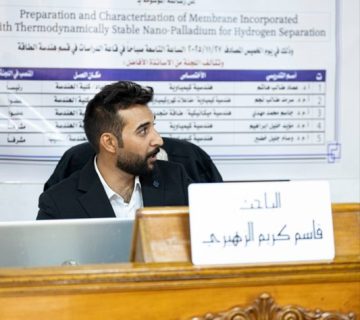The Petroleum Engineering Department at the College of Engineering, University of Baghdad, held a M.Sc. thesis examination titled:
“Carbon Dioxide Sequestration in Subsurface Formation to Enhance Hydrocarbon Recovery: Subba Oil Field – Nahr Umar Formation”
By the student Mahdi Mohammed Jawad Kadhim and supervised by Asst. Prof. Dr. Hassan Abdul Hadi Abdul Hussein. The examination committee consisted of Asst. Prof. Dr. Ghanim M. Farman as Chairman and the membership of Asst. Prof. Dr Adnan Ajam Abed , and Dr. Dhifaf Jaafar Sadeq. The thesis was summarized as follows:
The aim of this study was the achieving of the oil production target by carbon dioxide (CO2) from the Subba oil field, which is located in southern Iraq, southeast of Nasiriyah City. In this field Nahr Umar (NU) formation is one of main reservoir and is planned by Thi Qar Oil Company (TOC) to produce with plateau of 30 KStb/d using CO2 miscible gas injection and test the possibility of applied sequestration of CO2 in the aquifer as reduced emission project.
To achieve this, the first stage uses well log data and all available information from the final well report and final geological report is used to build a petrophysical model by Techlog-2015 Schlumberger software. Then a 3D geological model is constructed using Petrel-2017 software based on ten wells that penetrated the NU formation, along with a contour map obtained from the last 2D seismic interpretation and modified according to well tops. The NU formation consists of 12 reservoir units according to the updated geological study prepared by the Ministry of Oil in 2020, with 6 sand layers separated by barriers of shale. Then, this geological model is exported as a rescue file readable in CMG-2018 to sever as abased for the Dynamic model. The second stage involves using the PVT report to build a compositional model with WinProp-2018, determines the minimum miscible pressure (MMP) and activates the water solubility for CO2. The special core analysis (SCAL) reports contains ten samples for capillary pressure (Pc) and eight samples for relative permeability using J-function techniques to obtain a single Pc curve for NU formation, along with averaging and normalization abroach for relative permeability. The third stage includes constructing a 3D dynamic model with CMG-2018 based on a geological model exported from Petrel. To investigate distinct development plans with varying operational constraints. The compositional simulator (GEM-2018) is used to model NU formation, with the model calibration using Su-4 well testing because of a lack of production data.
Finally, the six production cases scenario has been suggested to develop NU formation as the preferred case based on the height recovery factor. The best case is the five-spot CO2 injection with a plateau of 30 KStb/d for twenty years with accumulation oil of 265.41 MMstb and recovery factor of 17.7 % also the production above the bubble point and with stored CO2 of 5.75 MMTon in the S21 and exploiting the three abandoned to stored CO2 of 3.265 MMTon in the aquifer as soluble emission gas.







